EDITOR’S NOTE: This is the third article in a three-part series about Dallas/Fort Worth urban wildlife found in the feral and untamed corners of the metroplex. If you haven’t already, I suggest reading the first two entries. You can find links to both below…
ARTICLE – This Place in the Woods – Deep Winter and Early Spring
ARTICLE – This Place in the Woods – Spring, Summer, and Fall
Dateline – Winter 2019 and 2020 – Denton County

Welcome back for another intimate look at the urban wildlife living in the deep, unreachable, riparian forest of the Trinity River bottoms. Let’s take one last trip into the woods as the pages of the calendar turn autumn into winter.
In this post I will be sharing trail camera pictures that were recorded in the same general location as those from the previous two articles in the series. With this entry—covering mid autumn through mid winter–we will close the loop on the year, finishing up at the same date where we started two articles ago.
All of the pictures presented in this post were recorded within the confines of a small half acre portion of a much larger forested area. For the purposes of this article, I further divided the space into four smaller areas—the North Glade, the South Glade, the Deadfall, and the Brush Pile (see the schematic map below).

the different areas of the woods monitored during this trail camera survey.
The North and South Glades are simply shallow depression in the forest floor that temporarily fill with water when heavy showers move through the area. The collected water works to keep the glades free of underbrush, and the resident wildlife responds by gathering in these hidden open spaces. The Deadfall is a massive Burr Oak tree that was toppled in a severe storm a few years back. The trunk of this tree is over four feet in diameter at the base, making the deadfall a perfect stage for animal antics. Finally, the Brush Pile is mostly made up of the branches of a long dead Osage Orange tree. The jumble of rot resistant limbs sits on top of a bed of fresh peat, which provides fine foraging for many of the forest’s local insectivores. These are the four specific places I monitored for this effort. The animals and activities at each spot were unique in their own way, and the pictures compiled from each spot will be presented in the order they were recorded.
Autumn
Brush Pile
We’ll start our look at autumn wildlife at the Brush Pile. The Brush Pile sits under the shade of a massive Burr Oak tree, which drops a virtual downpour of large acorns throughout the fall season. This abundant mast provides a bounty for acorn-eating forest dwellers like the charming Fox Squirrel.
The soft peat under the Brush Pile is attractive to bottomland’s insectivores—such as armadillos and skunks—as a nice place to forage. The loose soil combined with the tangle of Bois D’arc branches creates a nice framework for the construction of burrows—an amenity found appealing by armadillos, skunks, and pack rats alike.
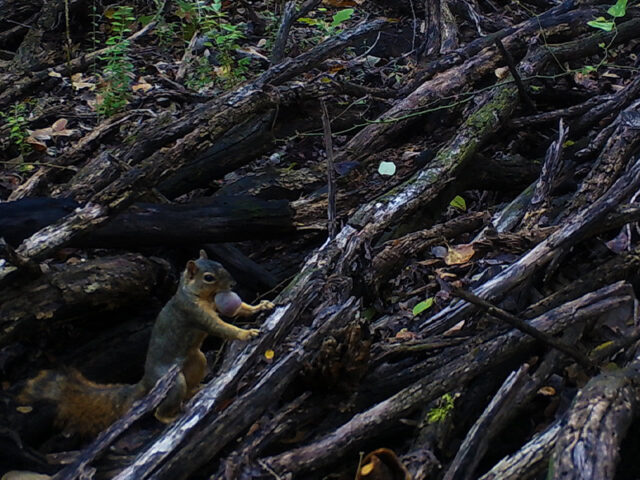

Deadfall
According to the calendar, autumn officially ends on December 21. But, in North Texas it is not uncommon for summer to hang on tenaciously, forcing the cool weather of fall to struggle to assert itself. In Dallas/Fort Worth we can have warm sunny days, with highs in the 80’s, well into winter.
On one particularly sunny autumn afternoon, the warm weather coaxed this rather large Texas Rat Snake onto the massive deadfall (see below). The higher temperatures certainly inspired this snake to get out for a little hunt. Texas Rat Snakes are nonvenomous and typically feed on rodents, reptiles, and eggs. They are some of the largest snakes found in North Texas, and this particular example was approaching five feet or more in length. That’s one big snake!
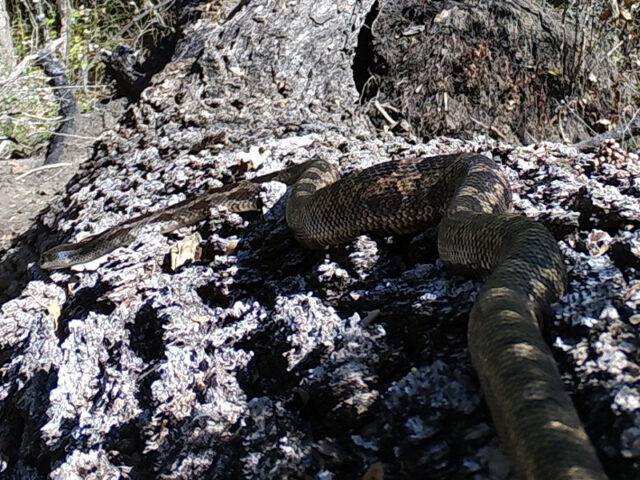
Mammals of all types also found the Deadfall an intriguing place to visit. Bobcats frequented the downed tree, sometimes treating it as a simple obstacle in their path, and other times investigating all of its nooks and crannies in search of prey. Occasionally, a momma Bobcat would stop by with her kittens. The dedicated mom would sit patiently off to the side while her babies rough-housed and climbed among the limbs and branches.
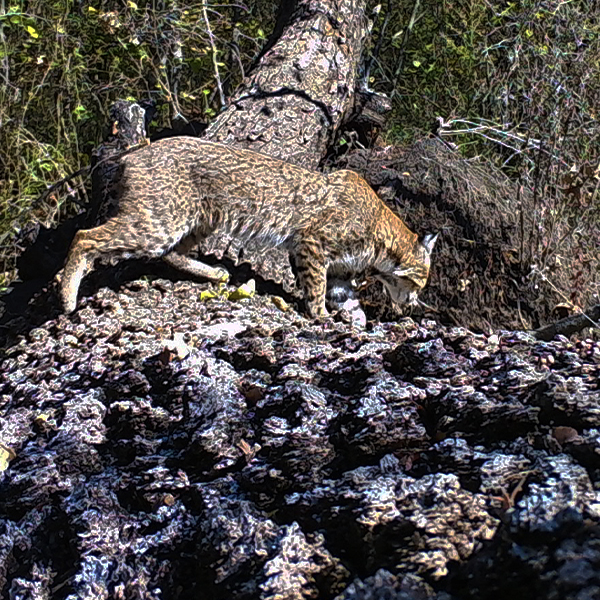

Raccoons, Fox Squirrels, and Coyotes all found reason to pursue their various objectives in the vicinity of the Deadfall. Squirrels typically used the massive trunk as a highway for transiting from here to there. Raccoons liked to gather here as a safe place to play or feast. The elevated vantage provided by the tree trunk gave the wary coons an added sense of security; a prudent precaution because of the network of games trails that radiate to and from the Deadfall. These well worn paths along the forest floor act as conduits guiding patrolling Coyotes to this spot on a regular basis.



Nightfall did not damper wildlife activity at the Deadfall. Raccoons emerged from the night-fog to forage on and around the massive tree. Where you find Raccoons in North Texas, you can be sure that Virginia Opossum will not be far behind. That was certainly the case on the Deadfall. Coyotes in their fluffy winter coats were regular visitors here as well; perhaps attracted by the scents left behind by the many other forest creatures passing through. An Eastern Cottontail was something of a surprise visitor to the tree-corpse, not because these rabbits are uncommon, but because the motivation for the cottontail to summit the Deadfall is hard to image. Maybe he did it for no other reason than just because it was there!

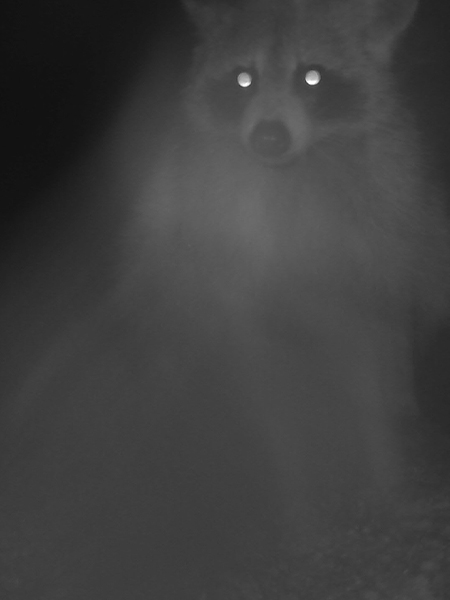




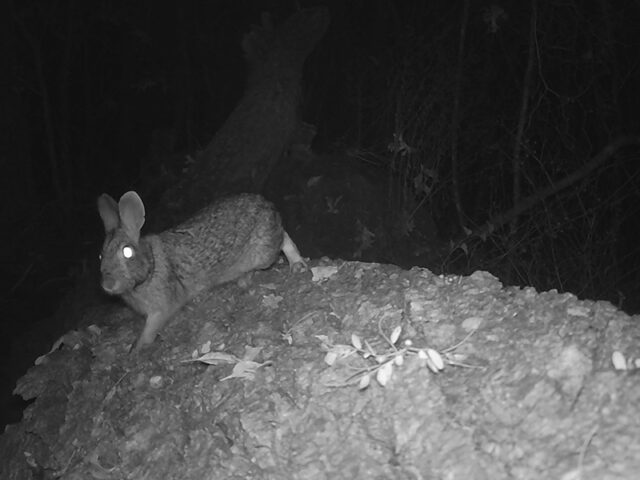
North Glade
As I hiked into the North Glade, I stumbled across this nice shed antler—a rare find in spite of the high deer population density in the area. My trail cameras had already revealed that there were many impressive and healthy looking deer in this part of the forest. As the cooler weather of fall set in, it was my hope that I would record many candid shots of these beautiful creatures. The bottomland White-tailed Deer did not disappoint.

The network of glades in this part of the forest were created in places where water collects for extended periods of time. The standing water discourages the growth of underbrush, creating clear pathways in an otherwise tangle of bottomland vegetation. Larger mammals like White-tailed Deer, and Coyotes appreciate the ability to transit the woods free of the usual encumbrances.
In some places—such as with the North and South Glades—these clearings can be relatively large. The extra space furnished by these glades are a perfect place for the resident big bucks to spar and have it out. Surrounded by dense woods, these places acted as virtual cage matches for the rowdy deer.
But those battles would happen later in the season. In mid-fall the glades mostly served as playgrounds for feisty first-year fawns. These open spaces deep in the woods provided plenty of room for young deer to run and chase and play—which they did with abandon (see the pictures below).
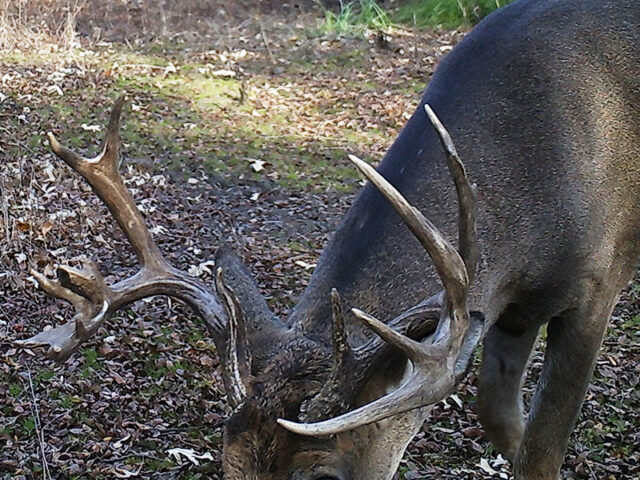




Deer Playing
Healthy young White-tailed deer have a lots of excess energy that needs to be burned off with regular play. But there is a serious side to all of the horseplay they engage in. Running and chasing helps these youngsters hone the skills they will need to spar and evade as adults. The intense exercise also encourages the development of strength and stamina.




Deer were not the only animal to make use of the clearing provided by the North Glade. Raccoons visited frequently—especially when there was water on the ground. Coyote family groups also regularly used this space as a place to congregate and socialize. And then some time in mid-December, an animal previously unseen in this part of the woods was photographed for the first time since the project began. More about this critter a little later…
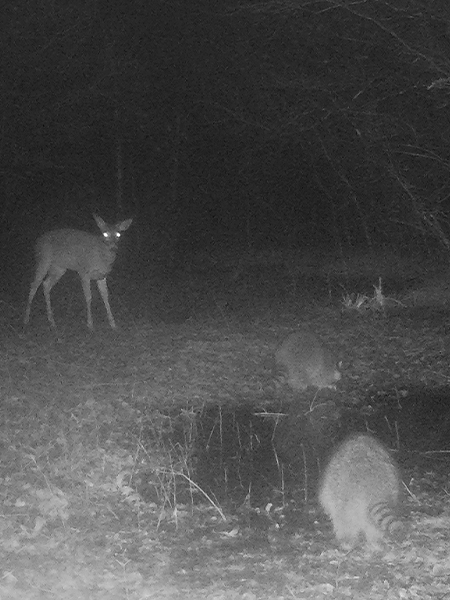
the close supervision of a resident deer

by another pair coming in frame on the top left.


And what about that mystery creature photographed for the first time in mid-December? Well, I had noticed a few clues that we might have a new addition to the forest fauna as I was hiking in to check my cameras. See the wildlife sign illustrated in the photographs below. Areas of overturned earth were clear indications that we had new visitor in this part of the Trinity River bottoms. But, had the critter stayed, or was he just passing through? And more importantly, did my cameras record pictures of him?


Many of you probably recognized the above animal sign as that created by one or more Feral Hogs. The big boar responsible for this rooting made his first appearance in front of the cameras in the middle of December. The lone pig was photographed several times before he abruptly disappeared just a few weeks later. When I returned to the woods to retrieve the cameras later in the winter, all of the hog sign I noted on previous visits had been completely erased by weather. Further, there was no new sign to be found anywhere. It was clear that the hog was gone. But, where did he go?
My guess is that there are two possibilities. One is that the hog simply moved on to another part of the river bottoms. The other is that he was killed by someone hunting illegally in this part of the urban forest. Of the two possibilities, I consider the latter the most likely.
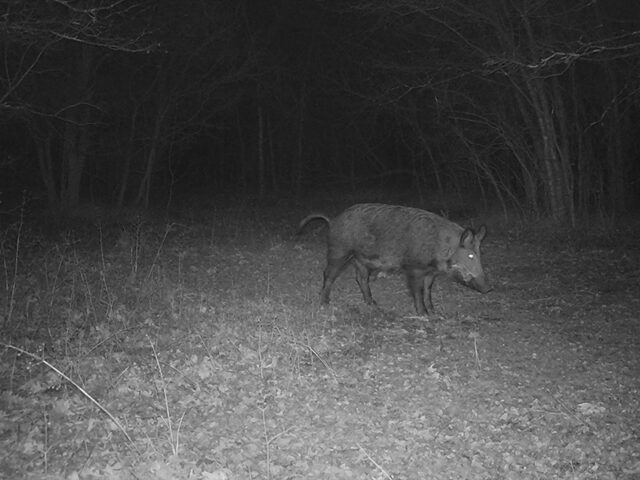
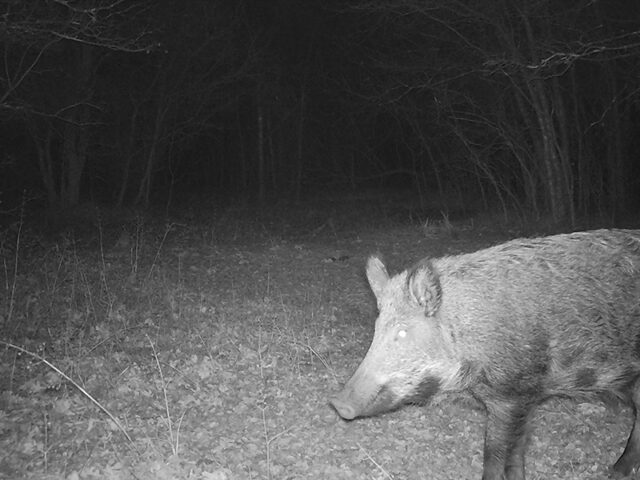
There is a history to this part of the woods that can be discovered to a degree through careful observation. The forest floor in this little half acre is littered with pieces of scrap metal and other indications that this spot was not always the way it is now. A nice example can been seen in the photographs below. These are downed utility poles located between the North Glade and the South Glade.


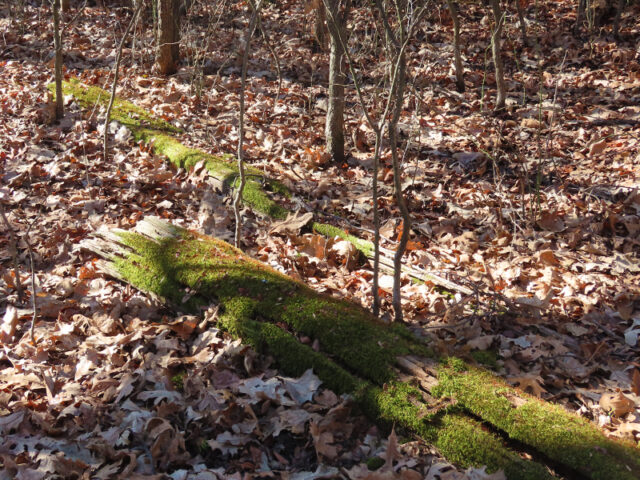
As I’m often inclined to do, I visited Historic Aerials online in an effort to learn more about how this land was used in the recent past. It soon became apparent that much of this area was cleared farm and ranch land as recently as just a few decades ago. Except for a smattering of big oak trees—many of which are still present and still dominating this part of the forest—most of the immediate area was tilled cropland. The building that was served by these utility lines is not readily identifiable in the historic photos I reviewed, but from all indications it was likely a barn or some some similar building.
South Glade
The South Glade is a little smaller than the North Glade, and as such it presents a slightly different dynamic. Nonetheless, there were plenty of deer that visited this part of the woods. In particular, there was a low hanging branch that was a prime attraction for any and all deer transiting this section of the forest.
White-tailed Deer are heavily invested in scent marking, and this special limb got more than its fair share of attention. Most of the deer that passed through investigated the mark. Many left scents of their own by rubbing the branch with their nose and mouth. Later in the winter the activity motivated by this scent mark would intensify significantly, but even in mid-fall there was an abundance of evident of what was to come. See the pictures below…




often inspired a little practice sparring
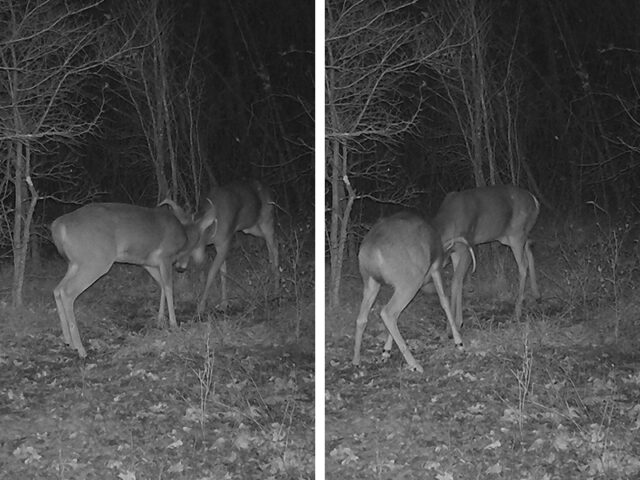
Again, deer were not the only critters present at this location. As expected, Raccoons and Coyotes aplenty were photographed in the South Glade. Our big black Wild Boar also made a brief appearance or two.
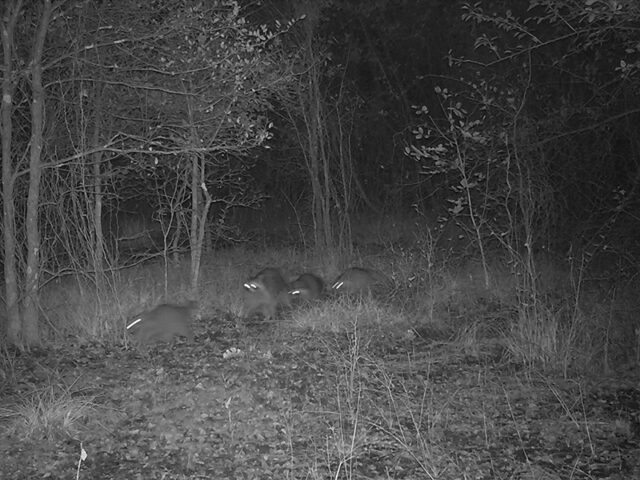

the camera during the witching hour

The Walk In
I check my trail cameras every couple of months. I use the opportunity to switch out the SD cards and to install fresh batteries. Often when I make one of these service visits I will bring my handheld camera along with me just in case I spot something interesting. Below you will find a small sampling of some of the pictures took on the way to and from my trail camera sets.







Winter
Brush Pile
In January I returned to the Brush Pile and found that it had been visited by a pair of young bucks. This time around a Raccoon was also photographed stopping by, as was an Eastern Cottontail.



They have to stay on constant alert for predators
North Glade
As we moved deeper into winter the North Glade became a very busy place. There are a number of big, mature, thick-necked bucks living in this part of the bottomlands, and they frequently came to the North Glade to engage in bouts of intense sparring. Since our last visit, January rain showers had refilled the glades with water, making the contests between big buck all the more dramatic and exciting to see.





Sparring Bucks
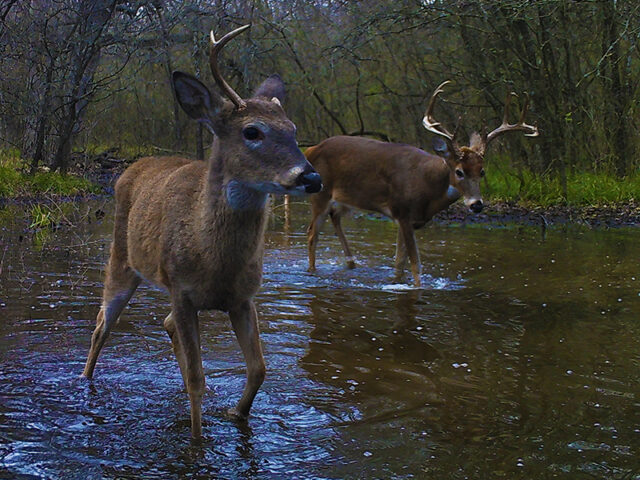
They do not, however, engage them in sparing matches
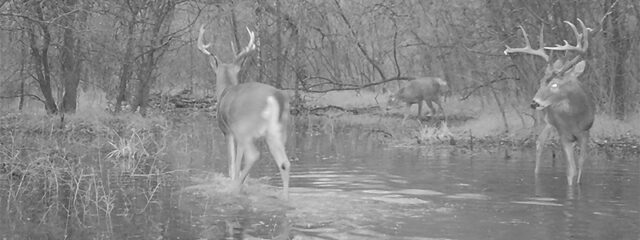
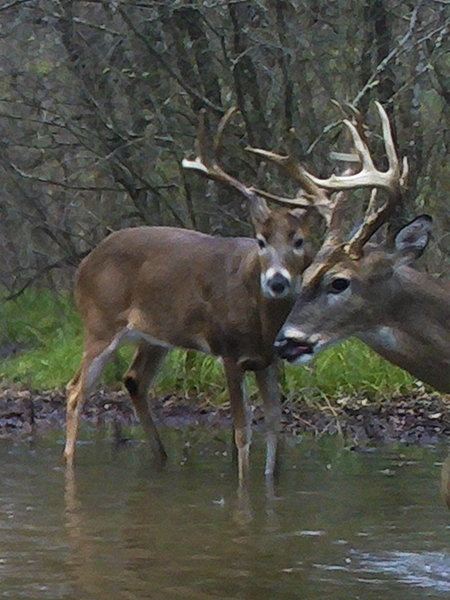



I shared many more pictures of these and other sparring bucks in the article linked below. Much of the action was spectacular to see. Many of the behaviors—especially those of some of the younger bucks—are very interesting. Please follow the link below to learn more…
Even into deep winter, the North Glade continued to attract an interesting array of wildlife—and some not so wild. Raccoons came to the clearing to search for food in the murky water. How they accomplish this objective in absolute darkness is beyond me. A Bobcat or two were photographed on a couple of occasions, usually after the water levels had retreated just a bit between rain storms. And finally, there was another little surprise at the North Glade when a Domestic Dog passed in front of the camera late in January. As you can see in the picture below, he has no collar. It’s not clear how this dog arrived in this part of the forest, or what ultimately became of him. This was the only photo of him that was recorded.
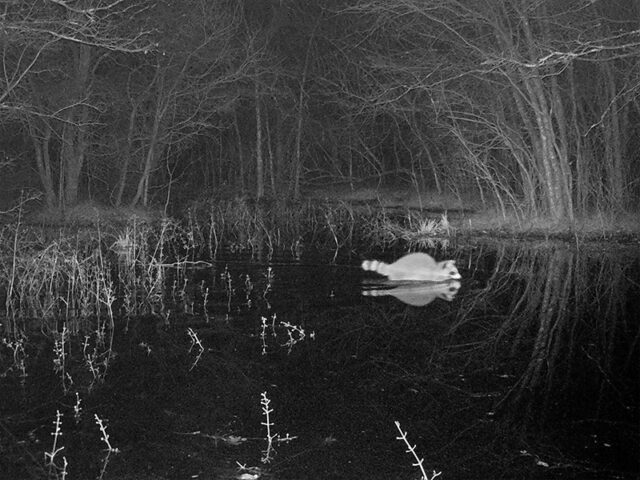
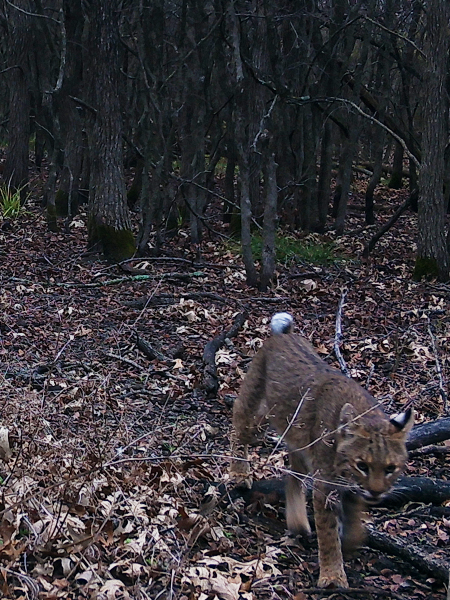

South Glade
The South Glade also remained a deer hot spot as we moved deeper into winter. The clearing formed by this glade help funnel deer from areas around the river into the North Glade and then back again. Most of the time, the deer passed through in close proximity to the scent marked branch over hanging the main game trail.

Scent Marking Deer
Scent marking behavior shown earlier continued to be the main focus of deer passing through this part of the woods. Nearly every deer—male or female, young or old—stopped to inspect the mark. A number of deer left behind scent marks of their own. Sometimes they marked with their noses and lips. Other times the tarsal glands were used. When a pair of buck encountered the mark at the same time it could lead to trouble.

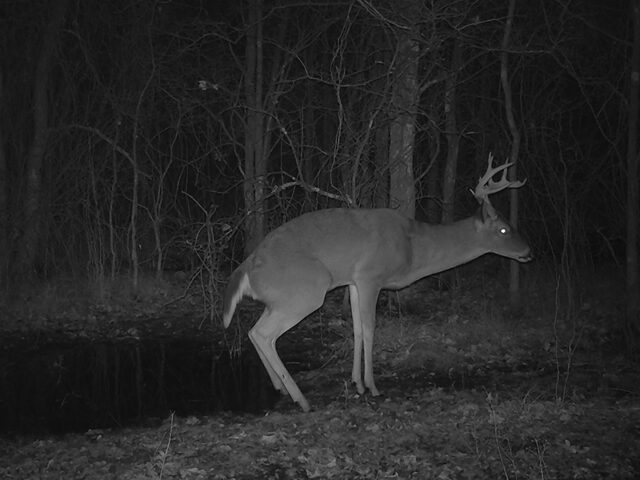

Sparring Bucks
All of this scent mark scrutiny served to thoroughly fire up the big bucks in this part of the forest. When two or more bucks were in close proximity, the scent marked branch really seemed to set them off. In spite of the more restrictive confines of the South Glade some mighty sparring contest resulted. See the pictures below…


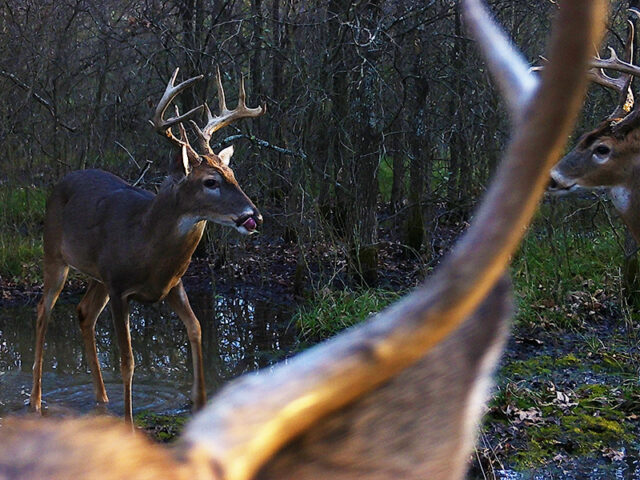


Other Articles in this Series
For articles covering the balance of the year at the same forest location, please follow the links below…
This Place in the Woods – Spring, Summer, and Fall
This Place in the Woods – Deep Winter and Early Spring








